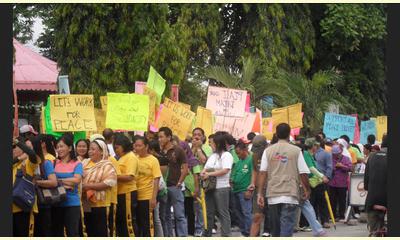|
|
One Step Closer to Peace in the Philippines
un articulo por Nonviolent Peaceforce
Video: Nonviolent Peaceforce in Mindanao
After four decades of violence resulting in some 120,000 deaths and displacing an estimated two million civilians, the Government of the Philippines (GPH) and the Moro Islamic Liberation Front (MILF) have now reached a historic breakthrough in the form of a Framework Agreement to end the conflict in Mindanao, Philippines. The agreement is to be signed at an official ceremony on 15th October 2012.

Peacewalk turnout with Nonviolent Peaceforce support, May 2011
click on photo to enlarge
“Peace at the negotiating table was made possible by the daily reality of peace on the ground over these past two years – itself the result of a unique experiment in unarmed civilian peacekeeping embedded in an official ceasefire mechanism. The success of this experiment now opens up new opportunities to replicate this model in other conflict settings around the world.” said Tim Wallis, Executive Director of NP.
As the only international non-governmental member of the Malaysian-led International Monitoring Team (IMT), Nonviolent Peaceforce was able to directly reduce the suffering and destruction wrought by violence upon the civilian population.
The first talks between the GPH and MILF began in 1997 and have continued sporadically ever since. Periodically, talks have been suspended due to major outbreaks of violence locals refer to as ‘all out wars’. Responding to the civilian crisis caused by an ‘all out war’ in 2008, the Government and the MILF signed an agreement in October 2009 to expand the IMT’s mandate to include civilian protection thereby giving rise to the Civilian Protection Component (CPC).
In 2004, the Malaysian-led IMT was deployed to monitor the implementation of the ceasefire and the peace process between the Government and the MILF. Its purpose is to ensure that the ceasefire is maintained and to create an environment in which the two parties can negotiate a sound and lasting peace.
Nonviolent Peaceforce will continue to support local communities and both Parties to ensure the safety and security of civilians in Mindanao.
Nonviolent Peaceforce in the Philippines has offices in the provinces of Sulu, Basilan, Lanao del Sur, Lanao del Norte, North Cotabato and Maguindanao with its main office in Cotabato City and a liaison office in Manila.
|








|
DISCUSSION
Pregunta(s) relacionada(s) al artículo :
What is the latest update on the peace situation in Mindanao?,
* * * * *
Comentario más reciente:
The agreement of October 15 2012 has given rise to optimism, but many problems remain. For a typical analysis see that of The Economist.
The Philippines' Southern Insurgency
It could be peace
Hopes grow for an end to a bloody and long-running insurgency
AFTER 16 years of on-and-off negotiations, the Philippines government and the main Muslim rebel group in the southern region of Mindanao, the Moro Islamic Liberation Front, agreed to the outlines of a peace deal on October 6th. The two sides are due to sign it formally on October 15th. If it works, which is far from guaranteed, it could bring an end to more than four decades of fighting by armed Muslims seeking independence from the mainly Christian archipelago nation. The Mindanao conflict has killed perhaps 120,000 people and displaced 2m more. Mindanao is home to most of the country’s Muslims, who make up about 5% of the population of about 100m.
The agreement is not a final peace deal, but rather what President Benigno Aquino describes as “a framework agreement” and the front calls a “road map”. Yet both sides believe that it paves the way for what Mr Aquino hopes will prove “a final, enduring peace” in Mindanao.
The peace plan envisages the establishment of an autonomous Muslim area in Mindanao, called Bangsamoro, subject to a plebiscite there. The proposed Bangsamoro will have budgetary autonomy and a just share of revenues from the extraction of southern resources; its own police force; and sharia law for Muslims only. . ... continuación.

|
|









